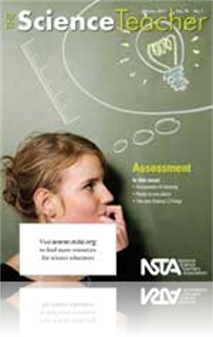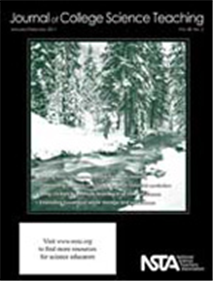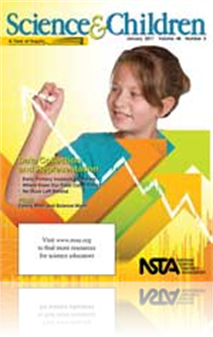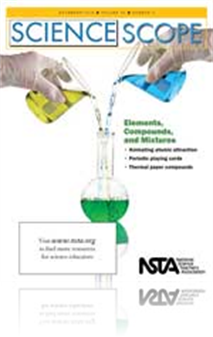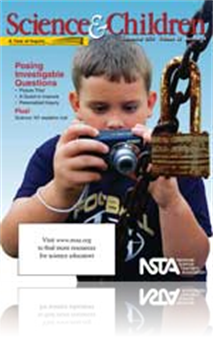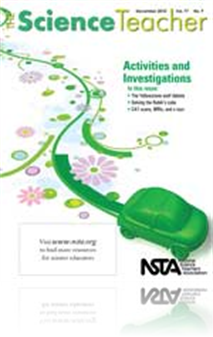All Resources
Journal Article
Want to learn something new about your teaching? Or discover what’s really working in your classroom? Ask the experts! No, not teachers or administrators, the real experts: your students. By the time they reach high school, students have logged ove...
Journal Article
Tried and True: Using Diet Coke and Mentos to teach scientific inquiry
Adding mint Mentos candy to a two-liter bottle of Diet Coke produces a fountain of soda foam that can reach 3 m high. A demonstration such as this can get a “Wow” out of most audiences, usually followed by a “Do it again!”—but can it be use...
Journal Article
Promoting the Development of Graduate Students’ Teaching Philosophy Statements
Teaching philosophy statements typically improve over time with teaching experience and instructional self-knowledge. Graduate students without this experience and self-knowledge risk producing lackluster statements when applying for academic positio...
Journal Article
Guest Editorial: Helping Young Learners Make Sense of Data—A 21st-Century Capability
Providing opportunities for students to ask questions about scientific phenomena they encounter in their world is a critical aspect of students learning science. Asking questions leads to students designing ways to collect data to support their claim...
Journal Article
Anatomy and Physiology I (A&P 1) has one of the highest failure and withdrawal rates on campus. To increase academic success, a course to supplement A&P 1 (Supplement) was developed and taught by anatomy and physiology faculty. Primary goals for the ...
Journal Article
Editor’s Corner: Assessment—Asking the Big Questions
Assessment is often synonymous with measurement. We use summative assessments to determine if and where a student will go to college, how much funding a state will receive, whether teachers will stay or be fired, and where the United States ranks in ...
Journal Article
Assessment <em>for</em> Learning
Due to the student-centered nature of problem-based learning (PBL) and project-based science (PBS), it is easy for teachers not to provide students with adequate feedback or enough support to promote critical thinking. However, research has shown tha...
Journal Article
This inquiry-based investigation focused on shadow measurement and the apparent movement of the Sun throughout the school year. Students would collect data about their shadows weekly. Toward the end of the year, students would then organize and inter...
Journal Article
There is a continuing need for engaging inquiry-based laboratory experiences for advanced high school and undergraduate biology courses. The authors describe a guided-inquiry exercise investigating the pH-dependence of lactase enzyme that uses an ine...
Journal Article
Science 101: What is the best way to represent data?
To answer that question, let’s look at various ways to represent data. Below are several situations along with graphs or charts that help visualize them....
Journal Article
Everyday Engineering: Ain’t she sweet—Bats, rackets, golf clubs, and all
The pitcher throws the ball and the batter takes a mighty swing. Crack! The ball is hit on the sweet spot and soars to the outfield. Or, you hear a thud! This time, the ball dribbles along the infield ground and the batter’s hands sting. Everyone w...
Journal Article
Editor’s Roundtable: A matter of confusion
Much of the information about atomic structure is too abstract and difficult for most middle level students to comprehend, so middle level teachers face a dilemma: If they introduce atomic theory too early and in too much detail, they may lose their ...
Journal Article
Teaching Through Trade Books: Thought-Provoking Questions
Why, what, and how: Three words that young students often speak when they are full of questions about activities and experiences in their daily lives. Helping students clarify their thought processes and ask a question that can be answered through sc...
Journal Article
In addition to meeting National Science Education Standards (NSES) related to the history and nature of science (NOS), reading or hearing about real scientists helps students connect with science emotionally. The authors have even noticed increased s...
Journal Article
As teachers, one of our most important responsibilities is to help students develop dynamic and useful views of science. Using current issues to create learning experiences can help generate student interest in science and help students appreciate it...
Journal Article
Safer Science: Building Safety Into Construction or Renovations
Designing a new science laboratory or renovating an existing one can be an exciting experience. Though science teachers may have a better understanding of laboratory needs than most administrators, many schools tend to limit or exclude them from the ...
Journal Article
The “Testable Question Relay” was created as part of a fourth-grade unit on conducting science experiments. In the relay, student teams raced to “outfit a scientist” by correctly categorizing questions as testable or untestable and earning sc...
Journal Article
Scope on Safety: Permanent safety in a temporary lab
In the last issue of Science Scope, the author discussed the science teacher’s role in the construction or renovation of science facilities. As a follow-up, in this month’s column, he will discuss how science teachers can deal with being displace...
Journal Article
A major goal of education is to help learners store information in long-term memory and use that information on later occasions to effectively solve problems (Vockell 2010). Therefore, this author began to use the Rubik’s cube to help students lear...
Journal Article
Science 101: What causes things to rust?
The simple answer is that things rust when you leave them out in the rain. But maybe you want a more thorough answer. Rust is a form of corrosion, which is broadly defined as the wearing away of materials due to chemical reactions. So corrosion appli...
Journal Article
"It's ELEMENTary, My Dear Watson": A Crime Scene Investigation With a Technological Twist
The Crime Scene Labs is a technology-enhanced unit with seven laboratory stations. Probes at many of the stations facilitate students collecting and analyzing their own data (some lessons are adapted from Volz and Sapatka 2000). The labs are designed...
Journal Article
The Early Years: Investigable Questions
Teachers may not need to teach children to ask questions, just develop that safe place where questions can be voiced, observe children to see the questions in their actions, and develop a culture that appreciates and records questions. An investigabl...
Journal Article
Having taught K–12 students and preservice teachers for almost 20 years, the author knows the problems that arise when students are asked to generate an investigation of their own design. Therefore, she developed some lessons that significantly inc...
Journal Article
What is the difference between an x-ray, a CAT scan, and an MRI?...
Journal Article
Formative Assessment Probes: To Hypothesize or Not
Formative assessment probes are used not only to uncover the ideas students bring to their learning, they can also be used to reveal teachers’ common misconceptions. Consider a process widely used in inquiry science—developing hypotheses. Perhaps...
Journal Article
The ingredient lists of your shampoo, makeup, and moisturizer are likely to include a dizzying number of unknown ingredients. What these ingredients are and do is a mystery to most consumers. However, many cosmetics contain ingredients that are linke...
Journal Article
Editor’s Note: No Dumb Questions, But. . .
Investigable questions are important elements of lessons that promote inquiry and help students construct meaning. Good questions help students make links between what they know, what they want to find out, what they observe, and how their observatio...
Journal Article
Every Day Science: December 2010
This monthly feature presents facts and challenges for the science explorer. ...
Journal Article
Digital photography energizes students and focuses their attention on their environment. The personal connection to science helps students develop a habit of mind in which everything they see inside or outside of school can prompt them to wonder and ...
Journal Article
A Life-Cycle Assessment of Biofuels
A life-cycle assessment (LCA) is a tool used by engineers to make measurements of net energy, greenhouse gas production, water consumption, and other items of concern. This article describes an activity designed to walk students through the qualitati...
Journal Article
Little Shrimp, Big Results: A Model of an Integrative, Cross-Curricular Activity
This integrative, cross-curricular lab engages middle school biology students in an exercise involving ecology, arthropod biology, and mathematics. Students research the anatomy and behavioral patterns of a species of brine shrimp, compare the anatom...
Journal Article
For scientists, the sandbox serves as an analog for faulting in Earth’s crust. Here, the large, slow processes within the crust can be scaled to the size of a table, and time scales are directly observable. This makes it a useful tool for demonstra...
Journal Article
Thermal Paper Exposed: The Secret of “Smart Paper”
This article discusses how, as part of a National Science Foundation-funded internship program, the authors translated smart papers into an exciting and informative activity for the middle school classroom. This activity opens students’ eyes to an ...



